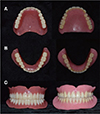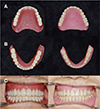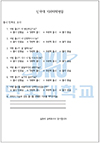Abstract
In patients with fully edentulous jaw, treatment of complete dentures should be carried out in many stages when following the conventional methods. Therefore there were disadvantages such as multiple visits to dental clinic is inevitable. In addition, errors caused by polymerization shrinkage, which happens during the fabrication of denture, and difficulties in reproduction of damaged or lost denture were considered as disadvantages. But nowadays, computer-aided design and computer-aided manufacturing (CAD/CAM) system is widely used in dentistry and it has begun to expand its spectrum in manufacturing complete dentures. Using CAD/CAM system to fabricate complete dentures can reduce the number of patient's visit and clinical chair time, since taking impression, recording jaw relation, and selection of artificial teeth are performed at the same time during the first visit, and delivering of dentures during the second visit is possible. In addition, because 3D-Printing technology is used, errors by polymerization shrinkage can be reduced. Among the companies that fabricate complete dentures using CAD/CAM system, DENTCA CAD/CAM denture (DENTCA Inc., Los Angeles, CA, USA) is the most commercialized company. In this case, we treated patients of complete dentures using conventional complete denture method and DENTCA CAD/CAM denture system in the same patient. We would like to report this case because we have achieved good results not only in functional aspects of pronunciation, chewing, and swallowing but also in aesthetic aspects.
Figures and Tables
 | Fig. 3(A) Separating the posterior part of upper tray, (B) Separating the posterior parts of lower tray. |
 | Fig. 10(A) Occlusal view of maxillary complete dentures (Left: DENTCA CAD/CAM denture, Right: Conventional denture), (B) Occlusal view of mandibular complete dentures (Left: DENTCA CAD/CAM denture, Right: Conventional denture), (C) Frontal view of maxillary and mandibular complete dentures (Left: DENTCA CAD/CAM denture, Right: Conventional denture). |
 | Fig. 11Denture delivery. (A) Frontal view of DENTCA CAD/CAM denture, (B) Frontal view of Conventional denture. |
 | Fig. 13(A) Occlusal view of maxillary complete dentures (Left: DENTCA CAD/CAM denture, Right: Conventional denture), (B) Occlusal view of mandibular complete dentures (Left: DENTCA CAD/CAM denture, Right: Conventional denture), (C) Denture delivery. (A) Frontal view of DENTCA CAD/CAM denture, (B) Frontal view of Conventional denture. |
References
1. Douglass CW, Shih A, Ostry L. Will there be a need for complete dentures in the United States in 2020? J Prosthet Dent. 2002; 87:5–8.


2. Zarb GA, Bolender CL. Prosthodontic treatment for edentulous patients. 12th ed. St. Louis: Mosby;2004. p. 190–207.
3. Bidra AS, Taylor TD, Agar JR. Computer-aided technology for fabricating complete dentures: systematic review of historical background, current status, and future perspectives. J Prosthet Dent. 2013; 109:361–366.


4. Fasbinder DJ. Clinical performance of chairside CAD/CAM restorations. J Am Dent Assoc. 2006; 137:22S–31S.

5. Kawahata N, Ono H, Nishi Y, Hamano T, Nagaoka E. Trial of duplication procedure for complete dentures by CAD/CAM. J Oral Rehabil. 1997; 24:540–548.


6. Inokoshi M1, Kanazawa M, Minakuchi S. Evaluation of a complete denture trial method applying rapid prototyping. Dent Mater J. 2012; 31:40–46.


7. Kattadiyil MT, Goodacre CJ, Baba NZ. CAD/CAM complete dentures: a review of two commercial fabrication systems. J Calif Dent Assoc. 2013; 41:407–416.

8. Goodacre BJ, Goodacre CJ, Baba NZ, Kattadiyil MT. Comparison of denture base adaptation between CAD-CAM and conventional fabrication techniques. J Prosthet Dent. 2016; 116:249–256.


9. Ohkubo C, Park EJ, Kim TH, Kurtz KS. Digital relief of the mental foramen for a CAD/CAM-fabricated mandibular denture. J Prosthodont. 2018; 27:189–192.


10. Infante L, Yilmaz B, McGlumphy E, Finger I. Fabricating complete dentures with CAD/CAM technology. J Prosthet Dent. 2014; 111:351–355.

11. Steinmassl PA, Klaunzer F, Steinmassl O, Dumfahrt H, Grunert I. Evaluation of currently available CAD/CAM denture systems. Int J Prosthodont. 2017; 30:116–122.






 PDF
PDF ePub
ePub Citation
Citation Print
Print












 XML Download
XML Download